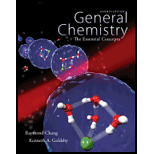
Concept explainers
Interpretation:
The given reaction data equation, formulas for the oxide and Sulfate of the metal M has to be determined.
Concept Introduction:
Ideal gas is the most usually used form of the ideal gas equation, which describes the relationship among the four variables P, V, n, and T. An ideal gas is a hypothetical sample of gas whose pressure-volume-temperature behavior is predicted accurately by the ideal gas equation.
A balanced equation is an equation for a
Answer to Problem 5.53QP
The mole ratio of
Therefore, the formulas of the metal oxide and the Metal sulfate are
Explanation of Solution
The moles of the metal consumed in the reaction
The moles of metal consume is calculated by plugging in the values of the given weight of metal and molecular weight of metal. The moles of metal consume was found to be
The moles of
The moles of
Compare the number of moles of
This means that the mole ratio of
We can now write the balanced equation since we know the mole ratio between
The unbalanced equation is
We have three atoms of H on the products side of the reaction, so a 3 must be placed in front of
The balanced equation is
From the formula of the metal chloride, we determine that the charge of the metal is
+3. Therefore, the formulas of the metal oxide and the Metal Sulfate are
The given reaction data equation, formulas for the oxide and Sulfate of the metal M was determined.
Want to see more full solutions like this?
Chapter 5 Solutions
Workbook with Solutions to Accompany General Chemistry
 ChemistryChemistryISBN:9781305957404Author:Steven S. Zumdahl, Susan A. Zumdahl, Donald J. DeCostePublisher:Cengage Learning
ChemistryChemistryISBN:9781305957404Author:Steven S. Zumdahl, Susan A. Zumdahl, Donald J. DeCostePublisher:Cengage Learning ChemistryChemistryISBN:9781259911156Author:Raymond Chang Dr., Jason Overby ProfessorPublisher:McGraw-Hill Education
ChemistryChemistryISBN:9781259911156Author:Raymond Chang Dr., Jason Overby ProfessorPublisher:McGraw-Hill Education Principles of Instrumental AnalysisChemistryISBN:9781305577213Author:Douglas A. Skoog, F. James Holler, Stanley R. CrouchPublisher:Cengage Learning
Principles of Instrumental AnalysisChemistryISBN:9781305577213Author:Douglas A. Skoog, F. James Holler, Stanley R. CrouchPublisher:Cengage Learning Organic ChemistryChemistryISBN:9780078021558Author:Janice Gorzynski Smith Dr.Publisher:McGraw-Hill Education
Organic ChemistryChemistryISBN:9780078021558Author:Janice Gorzynski Smith Dr.Publisher:McGraw-Hill Education Chemistry: Principles and ReactionsChemistryISBN:9781305079373Author:William L. Masterton, Cecile N. HurleyPublisher:Cengage Learning
Chemistry: Principles and ReactionsChemistryISBN:9781305079373Author:William L. Masterton, Cecile N. HurleyPublisher:Cengage Learning Elementary Principles of Chemical Processes, Bind...ChemistryISBN:9781118431221Author:Richard M. Felder, Ronald W. Rousseau, Lisa G. BullardPublisher:WILEY
Elementary Principles of Chemical Processes, Bind...ChemistryISBN:9781118431221Author:Richard M. Felder, Ronald W. Rousseau, Lisa G. BullardPublisher:WILEY





